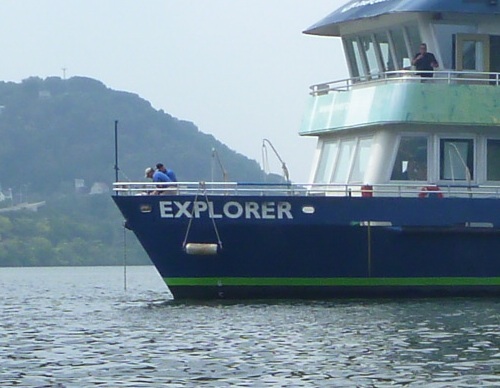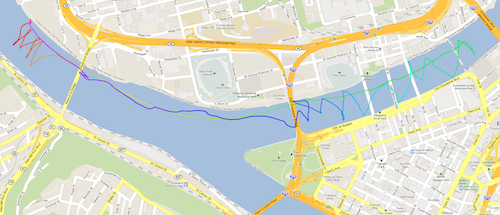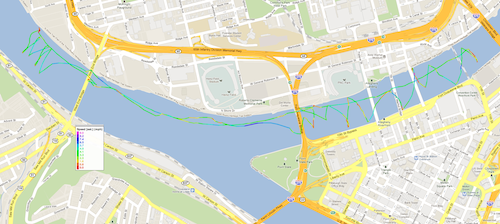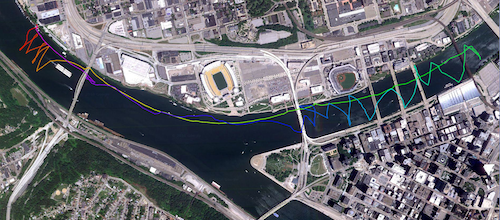What? A Sailboat?!
August 6, 2011
Today is Saturday. Yesterday, on Friday afternoon, I'd cycled over to the marina on the strength of a weather forecast calling for as much as 8 mph winds from the SE. By the time I'd arrived at the marina, I knew the winds were different, on the water at least. On the ride over and now at the dock, I saw the river surface was glassy calm, with a few puffs of wind passing over now and again. It was not a sailing day.

Saturday's forecast had been for thunderstorms. By late morning it was different. In fact is was a good day for sailing: 11 mph winds from the SSW. This was not perfect since winds with a southerly component tend to be blocked by ridges on the southern shore of the Ohio and Mon. But it seemed good enough. My hope was that the southern and western components would give good winds up the Allegheny. (The river currents on the Ohio, Allegheny, Mon and Yough were too low to worry about.)
For once, that it just how it worked out. I was in the water just before 1pm. The mostly southerly winds were blowing strongly downstream, away from the Point. I didn't measure them, but they were certainly gusting to 11 mph and likely beyond. I had a difficult time beating into those winds. The gps tracks below show my attempts at tacking into them What should have been zigzags gaining distance upstream are more crisscrosses, gaining only a little each time. I didn't know it then but the actual winds at that hour were up to 14 mph SW, before they dropped to more manageable levels in the 7-10mph range, mostly SSW for the rest of the sail.
With winds this fierce I needed to let go the sail to avoid capsizing. I was definitely "flying a hull" from time to time. That means the catamaran was heeled over enough to lift one hull right out of the water. I was sure of that, since, when I released the main sheet and the sail slackened, the hull would fall back into the water with a resounding "SLAP."
When I reached the West End Bridge, my beating into a head wind changed to a beam reach, with the wind blowing from the side. As usual, winds from the South West were funneled into the river course through the valley on the southern shore of the Ohio at the West End Bridge.
Those winds then moved behind me and I sailed on a run up the Allegheny.
As I neared the Fort Duquesne Bridge, my phone rang and then two messages appeared. I had no hands to pull my phone out of its waterproof pouch. So I took the opportunity to steer the boat to shore just upstream of the Fort Duquesne Bridge. It was time for some water and a river sailor's lunch of nuts and dried fruit. The water was much needed. With temperatures in the mid 80s, I was hot and dehydrating.
The riverboat Majestic came powering down the Allegheny as I rested on the shore.
I lay back on the deck to watch it rumble past.
Then I was back in the water, heading farther upstream. The winds were blowing pretty steadily from my back, so it was an easy run past my favorite golden bridges at 6th, 7th and 9th Street.
Finally I approached the rusty span of the Norfolk and Southern Railroad Bridge. It is the railway bridge just upstream of the Convention Center.
Passing under it, you get a view that only boats can see. It is pure Pittsburgh: steel, rust and old industrial strength.
Just upstream, I furled the sail and drifted to take in the view at my leisure.
Since my new camera is waterproof, I thought it might be fun to put it right on the water. The photos gives a good sense of how it feels to be a little body on a little boat, low on the water of a big river:
Then it was time to head back. If the winds had been exactly south westerlies, they would likely have blown right up the river course. But they were SSW and even briefly southerly. That means that they were sometimes obstructed by the southern shore of the Allegheny. So I managed to tack back with mixed winds, sometimes strong, sometimes calm and sometimes coming from unexpected directions.
When I reached the Point, it was time to head home. The southerly winds at the Point gave me some impressive bursts of speed--too brief to register fully on the gps track speed plot.
I had maneuvered awkwardly on the Allegheny to avoid the river ship Explorer. I'd ended up getting trapped under the shore-most span of the Fort Duquesne Bridge as it neared, since I didn't think it would be a good idea to share the main river course with it. Now, as I neared the West End Bridge and home, there was the Explorer again, right in the middle of the river under the Bridge.
This gave me some pause. Would I be able to sail past the ship? Or would it suddenly move off and run me down. I kept a close eye on it. It seemed not to be moving; or, if anything, drifting slowly backwards.
Then I heard five short blasts on a horn. This is how river boats signal each other. One long blast, I had learned from sailing past the riverboats docked on the Mon, means "leaving berth for river."
Now five short blasts means DISTRESS. I'd always imagined that it would be the last thing I heard before an unnoticed barge mowed me down. Were they warning me to stay away? That didn't make much sense. They were pretty much motionless and had plenty of room to maneuver around me. I was getting nearer.
Then I heard the five short blasts again, this time at a higher pitch. They were screaming! By now I was close enough to see a crew member on the bridge facing me and a pair of crew members peering down the anchor chain.

At this point, it was not too hard to guess what had happened. Somehow they had lost power and were drifting in the water. I'd noticed as I'd approached how much they had changed position. Their stern was coming closer and closer to the stone pier supporting the West End Bridge. Presumably, they'd dropped anchor to stop the drift, but the anchor was dragging.
My course would take me right under their bows. A cheery "hello" did not seem to be apt. So as I passed, I called out:
"Is everything OK? Can I help?"
That this suggestion was quite absurd somehow passed my notice until they shouted back:
"What?... A... Sail boat?"
Trying to recover my shattered dignity, I replied. "I heard your distress call--five blasts." I hope they realized I took it as a summons not to be ignored.
"Well," one crew member said, "We are in distress." Motioning to moored tug a few hundred yard away, he continued, "you could go over and ask that tug for a tow."
That seemed like a good idea. But a better idea came as a power boat approach. I franticly waived it down and relayed the message. I imagined they would get there faster and, being bigger, would be noticed more readily. When I passed the bows of the Explorer again, I told them what I had done. They said they'd already been in contact with the boat.
I was inclined to stick around and watch the end of the saga. But then a little sailboat is likely only to get in the way of a serious rescue. So I sailed off and a few minutes later (around 3:10pm) was docked at the marina. Looking back upstream through the docked boats, I caught a glimpse of a tug moving the Explorer. By the time I was cycling home, the Explorer was safely docked at its usual mooring at the Science Center.
John D. Norton
Back to main


